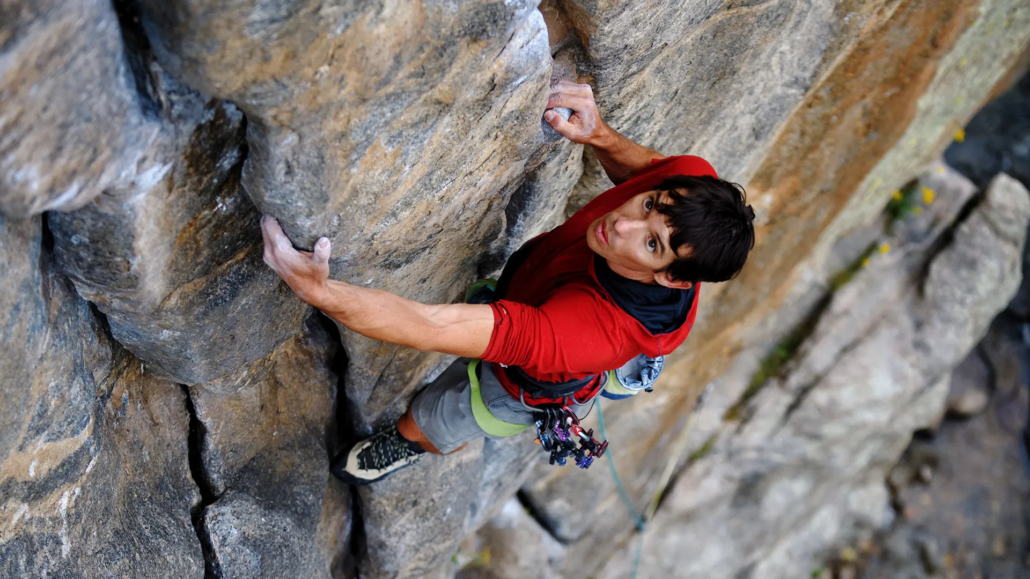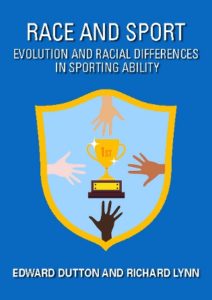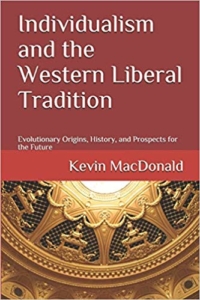Alex Honnold, Free-Soloing, and a Christian View on Race

Alex Honnold
Free Solo, instead, is largely about the intensity of knowing a person like [Alex] Honnold, of having someone so unusual in your life, and the ways in which he bewitches, excites, and frightens the people around him simply by doing his job.
Free Solo Is a Staggering Documentary About Extreme Climbing by David Sims, Atlantic Magazine (September 27, 2018)
I hate heights.
* * * *
My fear of heights has increased with age — I do not recall it being an issue when I was younger. While I have no fear of commercial air travel, I have developed an intense fear of heights — even modest ones. It struck me a few years ago when I hiked Crowders Mountain near Charlotte, North Carolina with my family. I took the “easy” path of seemingly hundreds of trail rock steps to the 1,600-foot summit, which offers incredible views of the surrounding area. Upon reaching it, I took one look around and decided that the view itself was too much: I began to have something more than anxiety but less than a full-blown panic attack. I almost immediately (and embarrassedly) tucked tail and made haste to descend the mountain. There are even more embarrassing episodes of my fear of heights that I will not belabor here (like my anxiety on Ferris Wheels) but the nub of my fear appears to be when the place of height lacks adequate (at least to me) safety measures. In any event, I am certainly — and markedly — afraid of heights now.
Understanding my fear of heights is important in understanding my reaction to the 2018 documentary Free Solo. Free Solo is not just a documentary about rock climbing in its most extreme form — it is an incredible journey in the psychological portrait of an obsessive type of Western man. The film follows professional rock climber Alex Honnold as he prepares to free solo El Capitan in Yosemite National Park. Free solo rock climbing is a form of climbing where the climber ascends without the use of ropes or protective gear, relying solely on their climbing shoes and chalk for grip. This style of climbing emphasizes the climber’s skill and mental fortitude, as any fall can result in serious injury or death. While extreme sports have become a fad of sorts in the last forty years — mostly individual sports that simultaneously push adrenaline and limits beyond measure — free solo rock climbing is perhaps the most extreme of them all.
El Capitan — or the El Cap — is a vertical rock formation in Yosemite National Park, on the north side of Yosemite Valley, near its western end. The granite monolith is about 3,000 feet from base to summit along its tallest face and is a world-celebrated location for big wall climbing. To see it — to see its almost flawless granite verticality — it is be stunned that anyone could climb even with the most prophylactic safety equipment let alone climb with none. Just looking at it gave me chills — it is that impressive. Alex Honnold was the first man ever to free solo this mountain — and this first was captured by Free Solo. It is never lost on the viewer (or at least this one) that this was easily a film that could have never seen the theaters had Honnold slipped to his death on camera. Watching him scale the face of El Cap is itself a marvel that he did not.
Three things stand about the work as a documentary. First, it is visually stunning. Any nature footage of Yosemite is bound to impress, and everything there seems almost prehistoric and larger than life. It is creation in its purest and most unadulterated form. The film captures this beauty and grandeur as well as any nature documentary has. The film zeroes in on Honnald’s climbing — and moves in, as it were, to the crevices, cracks, and depressions on the face of the mountain. Instead of the smooth appearance that El Cap has from a thousand feet away, it is a highly textured labyrinth of creases that the film highlights. Second, the film is a study into the mind of an extreme athlete — Honnold is a very unusual psychological specimen. The film does its best, albeit in very brief interludes, to offer some insight into the mind of a free soloist. Third, the documentary is drama-filled with ethical dilemmas and emotional strain. The people who assist and accompany Honnold on this journey — from his film crew to his fellow rock climbers who train with him; from his girlfriend to his mother — are struck by the problem of helping Honnold do something that is so incredibly dangerous on its face. That the filmmakers, who are Honnold’s longtime friends, might be filming contemporaneously his death is never lost on them. That his climbing companions may be training with him for the same is similarly difficult for them to process.
It is a mesmeric film — one that I was late, by seven years, seeing when it was first released. A close friend — someone who shares a similar personality, at least in some ways, to Alex Honnold — recommended the movie to me. Unlike me, this friend is someone who shares an affinity for extreme adventures. In a just a little bit different life, he could have been someone like Alex Honnold.

Alex Hannold at Yosemite
* * * *
Free Solo was a documentary that was acclaimed by virtually everyone who saw it. It won the Academy Award for best documentary in 2018 — and, based upon my research, every major publication — of every conceivable stripe — seemingly had something (universally positive) to say about it. In an age in which heroes are a dead letter and in which religion is a tacky anachronism, Free Solo strikes a chord for a type of man who is alive in doing something extreme. No, really extreme. It is a perfect statement of secular religion, or, at least, a type of secular religion. Embodied within it is a type of secular holiness that bears a relation, albeit for different reasons, for the hard things done by men in ages past. Man, in the age without God, seeks his Zen in highly idiosyncratic ways but it is to be found, or so he thinks, if that way is authentic and radically his own. I cannot recall a character who exemplifies Zen in the secular sense more than Alex Honnold. To demonstrate how powerful this image is, I, as a man who is deeply committed to the most retrograde and traditional form of Catholicism, found myself mesmerized by him. I too am a creature of my age.
But enough has been written — more in fact — about the mind of the extreme athlete in Alex Honnold. While he is, to say the very least, an intriguing and mystifying human being, most of what has been written about his documentary would be, to the extent he cared, agreeable to him. There is something else that fascinated me about him — something I think he would find it much less fascinating but just as compelling to me. That is, Honnold as the archetype of the Western man — the European man. Let me unpack that: Honnold appears to have generic modern liberal sensibilities. He is a vegetarian and an environmentalist. His foundation is based upon environmental micro-investments for impoverished Third World communities. He grew up in California. He ostensibly is irreligious and shacks up with his girlfriend in his home (a van). Other than his habit for undertaking this extreme activity, he strikes me very much as a man with conventional California liberal beliefs and views. While I would not describe him as a “hippie,” he is seemingly comfortable in their midst and aping their worldview (when he is not thinking about rock climbing, which is evidently not very often). To say that he would disdain what I am going to write it is to put it mildly, yet it was what struck me after taking in the whole of who — and what — this man is.
Let me offer politically incorrect assumptions on several counts and digress for a moment from free soloing. To situate my comments and observation, something must be said of race. First, races exist — not as social constructs, but as durable biological categories. Moreover, various races differ on average in myriad ways. The traditional understanding of race, which is just another word for the biological term “sub-species,” historically subdivided people into five categories: Caucasian (White); Mongoloid (Asian); Negroid (Sub-Saharan African); Australoid (Aborigine); and Amerindian. If race were not such a dirty word, I am sure that greater precision in definitional terms would have developed. Obviously, race is not so rigid that its categories are impermeable, and the borders between groups give way to zones of racial and geographical clines but the general proposition holds that racial groups differ from one another in meaningful ways. While “race” is an objectionable word among Western elites, “population groups” is a more anodyne way of saying the same thing among contemporaries. The meaningful differences between groups are something that can be registered internally but rarely spoken of in so-called polite company. So, that East Asians, for example, generally have a higher intelligence (as measured by a range of intellectual assessments) is noticed but seldom mentioned. That Sub-Saharan Africans surpass other groups in a variety of athletic feats (mostly those that rely upon fast twitch muscles) is similarly noticed.
We are not allowed to mention racial differences, in part, because of the implications of these differences — especially in modern, pluralistic societies like those common in the post-Christian Western world. It is not deemed an acceptable thing to say, for example, that the primary reason that African Americans do not obtain proportional admission (without substantial assistance) as a group to America’s elite universities is because they are, on average, less intelligent than the average intelligence of the competitor groups in Whites (which is just shorthand for European) and East Asians. Likewise, it is similarly verboten to say that the reason why African Americans disproportionately populate American prisons (and therefore disproportionately engage in anti-social criminal activity) is that they generally have a greater average tendency towards anti-social behavior, or, put differently, have lesser levels, on average, of self-control. Explanations for social phenomenon such as these are considered outside of acceptable discourse, and, as such, other explanations for different outcomes among racial or population groups must be considered. If one understands this, it makes perfect sense why, in an era in which racial discrimination is heavily penalized socially and legally, that a concept like “systemic racism” is used to capture an alleged mythical explanation for different racial outcomes — one that has no basis — as opposed to the more obvious one that racial or genetic distinctions largely account for different outcomes.
It is understandable to me why some have deemed race beyond acceptable discourse. There is something unseemly about it — something that offends good manners. If we accept that which we see in front of us — that is, racial differences obviously exist — we sense that there is an unfairness to it because race is, after all, an immutable characteristic that seemingly divests people of agency. The determinism of race has an ugly side. It seems plausible to me that many might accept the reality of race but deny its legitimacy of inclusion in public discourse because to do so would allow the public to use race as a shorthand for intelligence, work ethics, or criminality. Exceptions to average outcomes of course exist, of course; perhaps the thinking is that to allow a greater room for race to be included in public discourse is to allow unfair racial discrimination to flourish and create a self-fulfilling cycle of divergent racial outcomes.
The objections to taking race seriously come from more than Western liberal elites: they also come from the minority of committed Christians in Western societies. Christianity, as the great universalizing force in world history, rejects tribal or racial identity as particularly instructive, let alone destiny-making, in determining whether any man can be saved. To admit racial differences is to call into question, at least superficially, whether that maxim is true in the main. If all men are essentially equal in dignity before God and Church, which is what Christianity posits, then can groups of men meaningfully differ in racial attributes that make effecting that dignity real? I have struggled with that question for many years now as a committed Catholic — my mind and soul want the essential dignity of all men to mean that all groups are of equal abilities and attributes. Parenthetically, beyond religion, is not the American ideal of meritocracy predicated on such an assumption? But, upon years of reflection upon it, there is nothing particularly offensive about racial group differences and the Christian premise of essential dignity of all men. To a finer point on it, Christians readily acknowledge that differences of ability, temperament, and intelligence exist among individual men. Indeed, it is obvious as the day is long. I may be smarter, more athletic, and more peaceful than some but there are many who are better than me in every one of those regards. These differences do not call into question the essential dignity of all men — they co-exist. I do not feel inferior when I am around someone who is my better in some or all regards because I am essentially the equal of any man.
That different families, kinship communities, and nations should have similar group-level differences likewise should not call into question the essential dignity of men. That races, as the outer ring of population distinctions, also have differences as a result likewise should not be offensive. But more to the point, a reconciliation must be cognizable because I believe that Christianity is true and the faith as it is will never contradict natural truths. If race — and racial differences — are true as a matter of nature (and the powerful cocktail of geography, genetics, and time that make racial differences plausible), then racial differences and Christianity must be reconcilable.
For my own part, my intellectual and spiritual reconciliation of race and religion comes with certain moral demands: first, Christianity requires for the group as much as the individual that we exercise a profound humility. All have fallen and therefore no man or no collection of men bound by kinship is permitted to glory in themselves — only in God. That means even if we acknowledge differences, the relative hierarchy of men in view of those differences, whatever they may be, is irrelevant to their dignity as men. East Asians, for example, are not better versions of human beings because they are, on average, smarter than the rest of the world. It is difficult for me to claim that denying, for example, this reality (East Asian intelligence) is itself a virtue. Second, Christians are duty-bound to treat both kin and stranger (which is another way to say those from within and without of our racial group) with the same human dignity. The missionary impulse to convert all nations, given to the Apostles by our Lord, carries with an implicit conviction that all nations are worthy to be saved. Race then may be real, but it never warrants, at least for the Christian, a belief in essential superiority or inferiority of one group versus another on the plane of human dignity. But nor does it require, in service of the notion of essential human dignity, that we deny the existence of differences that exist among individual men or groups of men. They exist and make up what we might term the hard landscape of human existence in this world.
Race then is not a social construct — it is a principle derived from biology and nature. Men tend not to use it as a social concept or organizing principle. Race becomes relevant, at least to me, as a proxy for civilization. If civilization is the outer limit of human social organization and race is the outer limit of group differences, it makes sense, and is indeed borne out, that different races make different civilizations. European civilization is different from East Asian civilization and so on. Obviously, religion plays an outsized influence on civilization but so do racial attributes. The West looks like it does — the people within it have the assumptions and customs that they do — because, in large part, it was created by a particular racial group (Whites) who themselves had collective abilities and temperaments that fit the civilization they created. The same is true for every other civilization.
I am a White (read: European) American who is comfortable in Western Civilization. One of the demeaning characteristics of the elitist crusade against race is that Whites like me are — ironically — told that our particular race and our particular civilization (Western) is uniquely depraved (which violates the seeming social canon that race does not exist as a category and, in any event, should never be used as a cudgel against people born into that non-existent category). I became racially-conscious later in life (at about the same time I discovered my fear of heights) because of the official racial bias and bile that poured forth from elitist circles upon me and my own. To distill this further, when I had the full complement of children that God would give me, I found the racial bias and animus against them far more offensive than it had ever been against me. If my racial consciousness is offensive, and I am sure it is, the people to be blamed are the militant “anti-racists” in positions of power that showered upon me and my own that we are somehow qualitatively worse human beings for being born White. I did not believe that was true for other races; I will not believe it about my own either.
If my racial consciousness was initiated through what was essentially a negation of the official elitist hostility towards Whites, my evolution has been a more nuanced view based upon the positives of belonging to this group and civilization. To put it differently, I may have started this path in protest of racism shown towards me, but I have ended it with an affinity towards my own. To be sure, this is not a matter of racial superiority (indeed, my religion will not countenance it), but it is a recognition that my people — that is, Whites — are reasonable in wanting the perpetuation of their civilization, which can only come if Whites perpetuate themselves as a group. Under conventional conversational mores, it is perfectly acceptable for an African-American to indicate his or her preference for a Black spouse or their children’s marriage to a Black man or woman; to swap out, however “White” for Black in that sentiment is to, evidently, ride with the Klan. In that sense, I have a strong preference that my White children marry others from my racial group. While Catholicism trumps race in terms of marriage for my children, race is something too in the way that I think about it. Perhaps nothing more offensive could be said by a White man today — the truth is that I care little for the opinion of the people who it would offend. I see now, in a way that I did not see before, that Whites add something special to the world that is worthy of perpetuation. And if I can indulge the thought a bit more, Whites are, as a group, an unusually empathetic group of people — a caring race — which is why, or so it seems to me, God chose them to be the main missionary engine of His Holy Church. There is a double irony there. Whites are depicted by Western elites and race hustlers as uniquely evil as a group — the truth is something far different. To be clear, Whites are not a “new” chosen people and other races have different gifts too that I do not deny. But my view is that my people — my extended kin in the form of Whites — have co-created a wonderful civilization that is laudable. It is something that I can say that I am proud of without any form of customary “White Guilt”. Indeed, I refuse that now.
So native Europeans — both in Europe and in the vast European diaspora — have much to be proud of in the accomplishments of their people and the civilization that they created. They have been on the forefront of virtually every civilizational advance — and what is more, they exported those advances. The Chinese, in particular, match Europeans in many regards in their civilizational greatness but as is well known, they famously built a wall around their civilization instead of sharing it. In any event, from virtually every field of human accomplishment, Europeans have done incredible things for which is more than acceptable to both take cognizance of — and be proud of — as a member of that group and civilization. The world, as it is, organizes itself in a model given to it by Europeans — in arts, sciences, technology, culture, and economics given to it also by Europeans. And the question remains, why did the world tilt in such a distinctively European way? While that is a complex question, it does strike me that there is something uniquely curious in Europeans — something restless and adventurous among them. In every endeavor of human searching, Europeans have been among the forefront of discovery. Why is that? Prof. Ricardo Duchesne’s Faustian Man.

In his own unique way, Alex Honnold is an exemplar of this intrepid racial type found among a class of Europeans who fueled Western Civilization’s greatness. To look at him is not to see any particular attribute of greatness — he is seemingly an ordinary man. But his inner drive is Herculean — it is positively Faustian. His desire for excellence is otherworldly. And what makes him so unique is there is almost no hint of vanity or gain — he undertakes this incredible effort only to satiate his innate inner need to do it. Europe has produced men like this in seemingly every generation, and they are the great men of their ages. They did it not for fame — not for money — not for acclaim but because their nature made them reach for something beyond them and focus upon it with a monomaniacal obtuseness that is incredible to behold. In Honnold, I saw Alexander the Great. I saw Julius Caeser. I saw Constantine. I saw Saint Augustine. I saw Charlemagne. I saw Richard the Lionhearted. I saw Jean Parisot de Valette. I saw Columbus. I saw Hernan Cortez. I saw Pizzaro. I saw Oliver Cromwell. I saw Jacques Cathelineau. I saw Napolean. I saw Ernest Shackleton. I could go on, but I won’t. There is fearlessness and restlessness in the greatest of my people that manifests itself in magnitude for nothing other than the greatness of the challenge and the iron will to see it through. And to those who would say that Christianity crimps Western man’s greatness, behold how many of our best men were devoted Christians. Christianity, notwithstanding whatever Frederich Nietzsche said, does not create men without chests. We have had many Christian European men much greater than Nietzsche to ever count.
All the greatest mountaineers were European men — simply because, as Oswald Spengler realized, the urge to explore, to reach the highest, to do what no man has done before, is strictly a White male attribute.
1. Michel-Gabriel Paccard and Jacques Balmat were the first to climb… pic.twitter.com/3tK7MQfck2
— Dr. Ricardo Duchesne (@dr_duchesne) October 12, 2024
Even though Alex Honnold, in his breezy California liberalism would balk at the comparison and the point, he is nonetheless prisoner to a legacy that runs through his blood. He is a man who would rather die than compromise. He is a man who seeks something impossible because it is impossible. That Christianity lost my people in the main means that it lost people of singular greatness like Alex Honnold. I may see things more clearly, and I think I do, but I will never touch the greatness of a man like him in this life. And it has little to do with rock climbing but everything to do with the spirit of a warrior willing to sacrifice — willing to not count the cost of the battle before fighting. Alex Honnold is great not because he free soloed El Cap, as incredible as that was, but because he both wanted to do it and was willing to suffer the privations that accompanied it until it was accomplished, or he died. And while he would disown me publicly for my racial acclaim, I am proud that he is of my own kind.
Oh, that the Church might gain men like him again and my civilization and people might rise again. That we may once more put that distinctive European proclivity towards greatness once again at the service of Holy Mother Church. When this greatness is married to grace — when this otherworldly resolve is fixed towards God — the world becomes a European project for Christ. Oh, that might it be again.
Saint Boniface, Pray for Us.




 Race and Sport: Evolution and Racial Differences in Sporting Ability
Race and Sport: Evolution and Racial Differences in Sporting Ability


